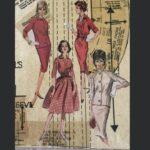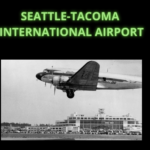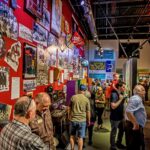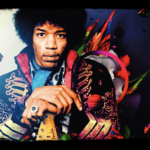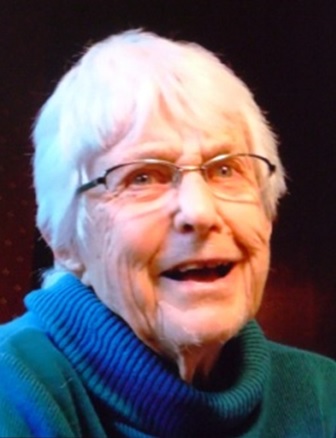Interview with Bobbette Keeler McIntyre
2012 December 11
Interviewer Barbara McMichael
BLM: My name is Barbara McMichael and the date is December 11, 2012. And it is my pleasure today to be talking with Bobbette Keeler McIntyre who has lived in Burien since 1920.
First of all tell me when and where were you born?
BKM: I was born in Seattle at 20th Avenue and Madison.
BLM: In a hospital or in a home?
BKM: In a hospital, but my mother told me that I was born in a brothel because it had previously been a very popular brothel at 20th Avenue and Madison Street. So that was “Bobby was born in a brothel”. Don’t tell me any more. [laughter]
BLM: And when were you born?
BKM: 1919
BLM: And did you live in Seattle long or did you come out to Burien —
BKM: I was 6 months old when they moved out.
BLM: Why did they move out here to Burien?
BKM: My dad was married previously and his wife died in the flu epidemic in around 1900, I think. And he was here because at that time there was a lot of work here, after the fire in Seattle. Anyway, after living through losing his wife he decided that he didn’t need to live in Seattle. It was dirty. And so he bought 3 lots out there on 152nd and that’s where we moved.
BLM: Now you were the middle daughter of 5 daughters total, is that right?
BKM: Yes. Mom lost a baby in ’25, I think. So I had 2 older sisters and then later on in ’29 or ’30 is when Monda and Norma were born.
BLM: Tell me about your childhood, growing up in Burien.
BKM: Well, there was neighbors, quite a group of neighbors. I’ve been writing about who lived on 152nd Street for quite a while.
I know the first person that lived on 152nd Street was Lockwood. They lived right on the corner of 152nd and First Avenue. And then next to them was Aries. She was a little younger than Mom. She had two boys. But they were younger. And then next was Mrs. Dahl. Her husband was, I guess, a stevedore or worked on the docks, loading and stuff. And then the next 3 lots is what Daddy purchased. And that left one lot on that first block and that was Mrs. Munson. And her husband went to the Orient for 6 months out of the year and ran a cannery. And I don’t know if it was in Japan or Korea or, some place over there. And then next to that was Casswells, they were next. And then there was a lady that lived in a little shack right on 152nd. All I remember was she was a real good friend of Mrs. Dahl. And then next to that was John Eder, the tinsmith, moved in in probably 1922. And then after Dad it was, [pause]…well, it might come to me later.
BLM: That’s a pretty good line up of people. So —
BKM: And of course there was all kids, dogs and kids run up and down Sylvester Road.
Of course in the springtime, it was roller skates. And there was always a fight because somebody else had the key to the skates, that we couldn’t find because the skates wouldn’t work unless you had the key to turn it. And everybody was blaming everybody else for losing the key.
The name I was trying to think of was Fitchetts. And he lived there. I always thought he was kind of rich because he had shoe skates.
Anyway, we would skate at certain periods of time or else we would play Annie-I-Over.
BLM: Tell me about that game.
BKM: Annie-I-Over? That is when you have sides and then you throw the ball over, they catch the ball and then they try to capture one of the others, we’d take him hostage.
And there was a building in between Mrs. Dahl’s and my dad’s property and it was vacant all the time and it was kind of a mysterious house. A tarpaper shack. It belonged to Mrs. Dahl’s brother. We thought there were people living there, you know. Because we would see Mrs. Dahl and she would be bringing up a saucer, and we thought she was bringing food for who’s ever in that house. Well, I know she wasn’t, she was probably bringing it up for rat poison or something. In my generation, we didn’t even go in the house. Now Monda came along and she broke into the house. And she said that it was a beautiful little box of Valentine’s cards, real lacy Valentine’s card. And she says today, “I don’t know what we did with those cards. We probably tore them to pieces.”
BLM: Now, Monda is your youngest sister?
BKM: Yeah. Anyway, at different times …of course, we had a horse and I did a lot of riding.
BLM: How far would you go?
BKM: Oh, all over Sunnydale, up on 16th, where the airport is. And then we’d go down to Seahurst. There was a girl and she had a horse, right in Seahurst.
BLM: Did you ever get down to Three Tree Point?
BKM: Probably did. Probably up at the top, up on the hill. I don’t remember going all the way down the twisty road there.
BLM: But up to Gregory Heights, around there.
BKM: Yeah.
BLM: Did a lot of kids have horses at that time?
BKM: There were quite a few. But of course that’s who we sought out to go riding with. Later on there was a riding academy at 146th on a hill, now it’s a park, on 146th South, across the street from Mr. Upper.
Now Mr. Upper was an English guy, small stature guy. And he had a horse and buggy. He would get that horse and buggy all rigged up. It was a really nice one, he took care of it. And he would ride, clip, clip, clip up the street, which was neat. I remember that.
BLM: That was for special occasions or Sunday outings.
BKM: Yeah, I think at that time where the Ruth School is, in a building there, that was a private home there, I don’t know who was in there. But they had a winding driveway and one time I saw him and he went down that driveway and it looked so picturesque and it impressed me at that time.
BLM: So you went to school at Sunnydale? Can you talk a little bit about that?
BKM: Yeah, I went to Sunnydale School. My first 8th grade teacher was Miss Allen, a sister of Martha Allen who taught the 8th grade when all of the 8th graders from the district, the 7 school districts, went to Highline and she was head of that department. The year I went to Highline was the first year they ever had all of that. All the 8th grades got together and so it was a good match.
BLM: So how many people were in if all of the 8th grades were consolidated. How many people did that mean?
BKM: Well, I think there was 6 teachers. I got all my report cards, I could probably tell you.
BLM: OK, maybe we can check that out later. Did you have a favorite teacher or favorite class? What do you remember about your grade school experience at Sunnydale?
BKM: Oh, Miss Kelly, my 2nd grade teacher.
BLM: What was so wonderful about her?
BKM: Oh, she could sing and she was pretty. She was a nice teacher. And I kept kind of in touch with her and I think she boarded with one of Wayne’s aunts when it was hard for her to get back and forth, because she lived out by the university.
BLM: When you say Wayne, you’re talking about your husband who we will talk about in a minute.
BKM: They had about 4 or 5 teachers that had a group and I imagine there was probably 35 kids in every group.
BLM: Can you describe Sunnydale a little bit? What the school looked like.
BKM: Yes, Sunnydale. The first year when I went to Sunnydale, the first grade was in a building, which was kind of a hall. And that’s where the first grade was.
And I was in a play, I was a poppy, in a play. I have a picture of that.
BLM: What was your costume like?
BKM: I think it just had a green dress and a big poppy that we wore on our head. I remember that.
I wasn’t very good in school, I’d rather ride a horse than do schoolwork.
In back of that school they served hot lunches. And that’s when Mrs. Morris. They came over from England, the Morrises. They had two daughters, Gwen and Cynthia. And they lived in the back of that building. And Mr. Morris was the janitor for the school. But then Mrs. Morris would make hot lunches, which I think was the first time there was any hot lunches in any of the schools. But she just took it upon herself to do that. So that was good.
And then by the time I got into the second grade, they had built a new school. Before they had bathrooms. Beings that my Dad was a plumber, we didn’t have an outhouse. No matter where we were we always had a toilet. I went to the girl’s restroom and I never saw such a mess in my life. It just stunk to high heaven. And there were slats in the back of it and all the boys were looking through the slats. That didn’t last very long, since the next year they fixed that up, we had regular toilets. It really was a mess.
For playground equipment they had where the bars went across and they could go around and spin. I never could do it, but a lot of them could do it. And they had a string of rings, about six rings, and you’d go back and forth on them. I think they had a teeter-totter.
When the new school was built, the basement wasn’t used and so that year, and I don’t know how many years after that, we had a skating rink down there. So we enjoyed that. Of course everybody would bring their skates. It was an activity that we always looked forward to that.
And then in grade school we had competition with others schools, like Angle Lake and Burien, for a pennant. So there was some rivalry there between the schools. Later on that year we were ready to leave Sunnydale and go to Highline, I was in the 7th grade. We had one school to play to win the pennant.
BLM: What sport is this?
BKM: This was basketball.
BLM: And was it girls and boys?
BKM: This happened to be all boys. Anyway, the school was down by across the street from the golf course, way down there —
BLM: Boulevard Park?
BKM: Some place I’ve got it written down. Anyway, because it was the last thing we did in the school, Mr. Kittleman decided we could all go down there to the game. And this school was not very fancy, it was just a bare bones school. And we had to stand out, the court had a floor, but the sides were all open all the way around and we had to watch the game through chicken wire. We thought, oh boy, we’re going to win this game. And there was one kid in there and he was a little bit bigger than the rest of the boys. Anyway we got beaten pretty bad. We didn’t like that kid – he made too many points. And then the next year when we went to Highline with the 8th grade I found out who that kid was and it was Steel, Ernie Steel, who played for the University of Washington later. And a very nice kid. He just made the athletic and put a name in Highline. At one point, one of the schools in Seattle wanted to move the whole family some place so he could play there, but that didn’t work out, because he had a girlfriend and he didn’t want to move away from his girlfriend. Which he married eventually and had kids.
BLM: Well tell me a little more about then as a high school student at Highline High School. What was that like and what were your favorite activities? And also what you studied in school, but also what you did after school. If you worked or what kinds of recreation you were involved in.
BKM: Well probably it was mostly riding horses because my oldest sister, she was a horse person.
BLM: That was Fern?
BKM: Yeah Fern. And then, I think during high school I boarded a horse. Some kid was going to the university and had to give up his horse, so he brought the horse, Billy, out. So I did that for a while. And tethered him out every day. I got to ride him too, so that was good.
The things that we did in school, of course, that was our entertainment. We had an operetta in the fall, and then a play in the spring. We had festivities type things like that.
And of course, my dad was interested in the PTA and so that was a gathering because all of the teachers came to the PTA. So you could talk to the teachers. It was kind of a – one time a lot of my teachers, Mrs. Gehrhart(sp?), she was a typical, she was my fourth grade teacher and she was this gray haired lady and she had her hair up on top and she had a ruler in her hand, old school, you know. I remember but she was an excellent teacher.
BLM: Now did most of your teachers live in the Burien area, or did they come out from Seattle?
BKM: Well, I think Miss Kelly, she lived at home and just one year they came out.
You know during that time it was in the ’30’s. It was a bad time. But if they were married, teachers were let go, they had to quit. They didn’t think it was fair that their husbands were working, they should have a job in the school because the younger [inaudible] needed the job. So we lost a lot, which was Mrs. Gehrhart(sp?) and Miss Hines. Miss Hines went to Federal Way and she was head of the school in Federal Way. So, I can’t think whatever other teacher, I can’t think who else.
BLM: If we can talk about that a little bit and the depression. Did your father work straight through it? As a plumber he was probably always —
BKM: Yes, he was self-employed.
BLM: So he probably didn’t. Did your family feel the hard times? And how did your parents respond?
BKM: I can remember going shopping. On the weekend we would go the Seattle Pike Place Market. I can remember seeing the bread lines down on the waterfront.
So it was bad, but you know the people that were living in Burien at the time, everybody had their own little patch garden, and some people had their own cows or goats. They sold to one another. There were several chickens, across the street from the high school was Young’s Chicken Farm, and that was a pretty good sized place.
BLM: I know that employed some high school students. I’ve talked with other people who worked at that chicken farm.
BKM: I went over there once and I stepped on the dog’s foot and he just about bit me. I wouldn’t go back again. But Mrs. Young had two children and I think one of them was Cynthia and I forgot who the other girl was, she was older. They were Fern’s age.
BLM: So did you meet your husband in high school?
BKM: I met him in first grade. I thought he was so cute.
BLM: Now say what his name is.
BKM: Wayne was so cute and he was real nice. And he wore, well it looked like it was a skull cap that maybe was cut off of a man’s hat, and it just had the crown. But it had all kinds of neat little mementos, whatever you want to call them, pins or something on them. He was really, really cute. He didn’t like me, he liked Marsina.
BLM: Well, how did you win him over?
BKM: I don’t know, I probably prodded him. We started to go together when I was a Sophomore, maybe he was a Junior in high school. He was a football player and he was a good kid. And his dad was the one, his stepdad wasn’t very good. And the more I think about, it was bootlegging.
BLM: Let’s talk a little bit about the bootlegging. What did you know about bootlegging when you were a girl and how did you find out about it?
BKM: We knew. Once in a while the cops would come down there to Mrs. Dahl’s place.
BLM: Ok, so they would raid Mrs. Dahl’s place?
BKM: Yeah, they would come down and if we kids were our playing in the yard or something, the cops would tell us to “go get in the house now”.
BLM: Did they come out in a car? A couple cars?
BKM: As I remember it kind of looked like during the war with the Nazi’s driving in and a guy, the driver and the passenger, and two guys sitting in the back all holding their guns. Anyway, maybe they didn’t have guns, but we went in the house.
About why they were there, I think they [Dahls] made their own beer and I don’t know whether that was legal or not, or if they could get arrested for that.
But I think what they were really after when they raid was hoping to get her brother who Daddy said was a rum-runner. I guess that was pretty, I don’t know what a rum runner does, whether he goes up in the straits and where the boats come in from the Orient. They try to meet up with the boat and it was the captains on the boats that had their own stash of rum. And this was just a little side-line, I think, for the captains. They would strike up a deal and they would come down like, if the boat was going to Tacoma, they would stop at Normandy Park, because that’s where they just had to roll the rum out there and put it on the beach for someone to come and take it. I don’t know how it was policed between them but that’s how Daddy explained it one time. But, I didn’t see anything like that, but I guess that was going on.
BLM: Any other bootlegging?
BKM: When I was going with Bill in high school, there was a lot of drinking and parties.
Wayne used to say it was hard to, what started it was hard because his stepdad – I have to go back, to probably 1921. Wayne had a sister and that was the year she was born. His real dad, they had been to Arizona. And his real dad, she [Wayne’s mom] divorced him and she came up here. But during the time of about 1922 to 32 they lived in Portland. Wayne said they lived in a real nice house and a nice neighborhood, they had a grand piano. His stepdad bought him a bike and he had all these things. But something happened in Portland. And I guess the stills blow up sometimes, I don’t know how they work, but somebody was either injured or killed, so they moved the operation here, up on the old homestead, the George Wilcox homestead. Wayne was the last one, male, to die related to George Wilcox.
BLM: And where was the homestead located?
BKM: It would be right in the middle of the airport on 16th. And that street, 16th, going north, it went all the way down to where the, Three Tree Point, Des Moines Road, the old one that went through. And it was all filled up with relatives, practically because when they were here and he had a sawmill there, the old man Wilcox. I guess it was a pretty good deal, a big place. But everybody was, seems like they were relatives or in-laws, maybe outlaws
BLM: So your husband, Wayne’s stepdad was involved in some kind of, at the time, illegal activity.
BKM: Yes.
BLM: Did he have other work or was that just a way that he was able to support the family?
BKM: You, know, I think he was a person that, he was a big guy. I think he made very good whiskey because he had it in with the sheriff in Seattle. And the car would come out there and Wayne said they’d pick up a jug of, it was. But he was a [inaudible].at one time [inaudible].the house, I don’t know how it happened, but two of his former wives were there. I don’t know, he was just kind of a person that took care of everybody. I don’t think I ever saw him drink anything. His name was Frank Callopy(sp?). I think if someone researched the papers that between 1920 and 1932, they would probably be able to run across him being picked up for something.
BLM: So they did occasionally have run ins with the law. Occasionally, they wouldn’t look the other way.
BKM: They would look the other way. Yeah.
BLM: They usually did but sometimes they did not?
BKM: Yeah. So everybody probably drank whiskey. And they probably got it from Callopy(sp?). It was prohibition, but you didn’t go to a party out there, but what there was liquor. And anyway, I married into that. But one time he [Wayne] said there was a false wall some place in the house.
But I don’t think his [Frank’s] still was at the house, because if it was, I understand you have to have running water to make a still. And they were out of water because Wayne used to go and haul water up there when we were going together. So he [Frank] must have had some place on Miller Creek where he had set up a still or whatever.
He [Wayne] remembers one time that he went with Frank Callopy(sp?) and he was riding in the car with him and of all places, they were riding down Sylvester Road and he [Frank] was stopping and putting a bottle or jug or whatever of whiskey beside every tree along there. Now I don’t know why he would do that, other than it was getting close to being caught, maybe. Anyway, Wayne said he was hiding, he was about 7 years old, so that would have been in the mid 20’s.
BLM: Let’s go on to talk about your courtship. So you were going out with this cute football player, then did you get married right out of high school?
BKM: No, a couple of years.
BLM: So as far as dating goes, what would you do on a typical date?
BKM: Well, it was usually going to plays at school or it was to games. And they had, in school we had Girl Reserves, which was kind of a YWCA thing, and then the boys they had, I can’t remember what they called it, but it was almost the same thing. Then they had their functions together, you know.
And one time, I think my first date with Wayne was going down to the park on the other side of Saltwater Park.
BLM: Saltwater, or Dash Point? Dash Point is further on. You went to Saltwater?
BKM: Yeah. And we walked up there, there was a maidenhair fern, and he swiped a maidenhair fern for me. To this day, I have maidenhair ferns.
You had to make your own stuff. We had beach parties. Wayne had, I think it was a hupmobile, it was the ugliest looking car you could have, but it ran and that’s all he needed.
BLM: So when you got married was it a formal wedding?
BKM: Oh yes. I still have the dress. We were married in the Presbyterian Church, married by Mr. Gilbert, a school teacher. You probably heard of him. He married all of the family.
BLM: Did you go to that church regularly?
BKM: He kind of went to different churches, but we had to have Mr. Gilbert because he married the whole family. That was par.
BLM: And then did you buy this property here off of Sylvester Road right away, or did you live somewhere else once you were married?
BKM: When my dad was growing up, his dad was a teletype operator with the railroad and so the family, four boys and a girl or something like that and they never had a home. Daddy was the youngest one. And all he wanted to do was to have a piece of property and a home. That was his idea. And so he drove into us girls that before you get married I want you to look for some property. I don’t know if he wanted his girls to be close to him or just what but you have to have a piece of property.
So every one of us bought a piece of property. We bought this here and it was a shy acre. Of course all I wanted was a stream that runs through it. We bought it through the realtor. The stream was just from the down gutter, but it was a stream, so there was a stream here, you know. We probably paid $20 down and $10 a month. So we bought the property. And then of course, Fern bought the 15 acres down here.
BLM: That’s down off of Des Moines Creek.
BKM: Uh huh.
BLM: And what about Ann?
BKM: Ann bought where the creek goes, Miller Creek goes through the airport, right on 160th, she had a house down there. In fact, she had two houses down there. And Monda bought some on 136th and Norma bought one on top of the hill not too far from where Mr. Upper used to live.
BLM: 148th or so.
BKM: So we all had a piece of land.
BLM: Then how long did your dad hold on to the property at 152nd, your folks. Did they hang on to it for a long time?
BKM: Oh yeah. Thank God for Social Security. See that just came in ’32? My dad was not a saver. If he had money, he spent it. And he was not a business man.
He loved to do things for us kids. He made a playhouse, a three room playhouse for us in the back yard. The living room had a fireplace in it, a little fireplace. Then there was the kitchen and then he had a little iron stove. And then I was the youngest so I got the upstairs. That’s where we had stairs going up and then we had a slide that went down with a bump in the middle. So we had a slide from the stairs down.
BLM: You were the youngest until about 9 years later.
BKM: Yeah. I was Daddy’s helper. I admit I was spoiled a lot. But he would make us toys.
There was a big tree, I think it was probably in the alley of the house in back. And he got some cable and ran it down to the spooky house next to Mrs. Dahl’s. And we would get on a trolley and hang on it and go all the way down and at the end we’d hit,
Daddy had some mattresses so we wouldn’t hurt ourselves. So we had that and all the neighborhood kids were there too.
And he made merry-go-rounds. I think he got bed rails, the heavy bed rails, put them together and had them welded together and then he’d tie tires, so that we could run around and do that.
Then he’d topped all the trees because he didn’t want them blowing down. And on each one of them he’d put a little stand up there so we could climb trees and sit on top of the trees. Then we used to send notes back and forth, we’d tie a string and then we would put notes on it. Ann and I would play that way. I didn’t like climbing the trees though. I’d get up there and couldn’t get down.
I can’t think what else he made. He liked to have us kids, I mean the house looked like he had a lot of money, but really we didn’t have a [inaudible]. But there was one thing I remember, like I said before, we always went to Pike Place Market on Saturdays, most Saturdays. And there was a place in Des Moines, it was just beyond, on Des Moines Highway just a little bit beyond 152nd. And it was a house that was kind of set on a knoll there on the right hand side of the road.
BLM: When you say right, do you mean east or west side of the road.
BKM: It was the east side of the road. And they had a pool there, and I don’t know if it’s my imagination or not, but I just assumed that it was nice with the pool and the shrubs around it and everything. But in the middle of the pool was a little black boy. And he had a little, he had just fished out a shoe and the water was coming out of his shoe. And every time I think about that now if Burien could find that little thing that would be a nice thing to put in the middle of their —
BLM: You know who else had talked about that, Betty Vacca. Did you know Betty Vacca? Well, she married into the Vacca family. She has talked about that very thing. It made quite an impression on people, I think.
BKM: And later they had an article in the paper about it. And someone had got it in North Seattle.
BLM: She saved the article in the paper, something about a shoe company or something that had bought it. If I find that information I will let you know what it is.
Before we finish up, let me ask a little bit about the family that you raised then. Tell me about your children and when they were born and did they go to Sunnydale also, or would they be going to a different school here in Highline.
BKM: They went to Sunnydale first.
BLM: So tell me, you had three kids.
BKM: Yeah.
BLM: Karen, Julie, and Bill.
BKM: Well, I know Karen went to Sunnydale. Now when Julie came along, I think she went to Burien. Well, there was a school up here, Lakeview. And I think Bill and Julie were in Lakeview.
BLM: Julie was born in ’46, and Bill was born in 1950. That’s the era that they went to. Did they just walk up to school or did they go by bus.
BKM: Oh, yeah, they walked.
When you speak of the busses, I think that the first time they had a bus in the Highline District was when the school took, McMicken Heights, they had to get a bus to bring those kids to Sunnydale. And that was the first bus that they ever had in the district.
No we walked every day to school and that was a mile, a little bit more. It was kind of muddy sometimes and I was–
BLM: It’s what you were used to though. You wore your galoshes, I suppose.
BKM: Oh yes, yes.
My dad he liked art, artists. One day he decided we should have raincoats. Well they kind of looked like fisherman’s orange raincoats, you know. And he drew on them, in color and everything, all of the characters from the funny papers. And I would just love to have kept those.
But, I don’t know, we managed to survive.
BLM: Well this has been a very wonderful conversation. Is there anything more that you want to make sure that we capture on tape?
BKM: I can’t think of anything else.
BLM: Well, thank you very much for your time
BKM: I hope I explained everything in the right way.






